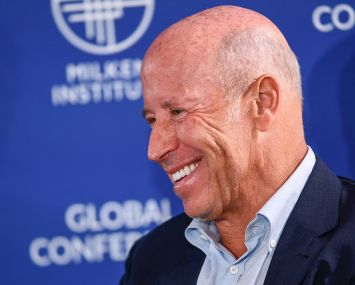Five Years Post-Stock Market Crash, How are CRE Pros Faring?
By Lauren Elkies Schram March 12, 2014 7:45 am
reprints
 This past Sunday marked the five-year anniversary of the lowest point in the stock market crash which sent everyone, including New York City’s real estate market pros, reeling. In late 2010 and early 2011, New York City essentially recovered from the economic meltdown but business hasn’t always been rosy since. Commercial Observer checked in to see how the city’s commercial real estate brokers were doing five years ago and how they are faring today.
This past Sunday marked the five-year anniversary of the lowest point in the stock market crash which sent everyone, including New York City’s real estate market pros, reeling. In late 2010 and early 2011, New York City essentially recovered from the economic meltdown but business hasn’t always been rosy since. Commercial Observer checked in to see how the city’s commercial real estate brokers were doing five years ago and how they are faring today.
Francis Greenburger, founder, chairman and CEO of Time Equities
1. When it comes to your real estate business, where were you then?
I have always been committed to running Time Equities Inc. in the same manner, even during the most challenging times. I continued to quickly adapt to market changes and find solutions to the tough problems. I believe that to succeed in the real estate industry, one has to have a keen sense of value in the long-term and be extremely flexible and opportunistic.
2. What did you learn from that period?
I was again reminded of the fragility of our banking system. During this period, I knew that there was unforeseen value in waiting, as well as taking a hold of opportunities right away. I, along with my team, always stressed the importance of focusing on the long term. I first experienced this fragility in the savings and loan crisis of the late 1980s.
3. And where are you now?
For more than 45 years, I have continued to lead TEI by quickly adapting to market changes and tough challenges in the industry. Currently, our firm’s portfolio spans the country, Canada and Germany, consisting of more than 20 million square feet of property. In addition, we are in the midst of developing the highly anticipated luxury residential tower, 50 West, that will rise in Lower Manhattan.
Daun Paris, president and co-founder of Eastern Consolidated
1. When it comes to your real estate business, where were you then?
Five years ago were boom times. Eastern Consolidated was coasting along on the success of our business line focused on the $25 million to $125 million range. We were coming off five consecutive years of incredible transaction growth.
2. What did you learn from that period?
We were mindful that the market was at an all-time high and wouldn’t last. We had learned from the crash of 1989 the importance of a large cash reserve. If you remember that time, the investment sales market went from more than 35 firms to less than a handful. That downturn presented an opportunity. While most of the competition dissolved, we moved to 30 Rockefeller Plaza, tripling our size.
3. And where are you now?
When the bottom fell out this time around, we took this opportunity once again to re-evaluate our business. We saw that we had organic growth opportunities that would allow us to better serve our clients and support our brokerage team. We have grown our brokerage team since then by more 300 percent, focusing on rising stars, and have launched a new retail leasing division. We have additional new hires on the way. And year-to-date we already have four times as many transactions in the pipeline than we had all of last year. We’ve come back stronger than ever.
Robert Stella, principal at Cresa New York
1. When it comes to your real estate business, where were you then?
Then, the business world felt like it was dead. There was panic, uncertainty and no proven plan. More than 15 million square feet of office space was dumped back on the market in six months. Parts of the New York City commercial market dropped 50 percent, particularly at the higher end properties. It seemed as if nothing happened for nearly a year.
2. What did you learn from that period?
I learned firsthand that once every 80 years there is going to be a huge economic correction. They did not cover that in economics at business school, though history has proven that theory for the past 200 years. May those around 75 years from now get ready!
3. And where are you now?
Today we all have adjusted to the new normal. Businesses have made their corrections and real estate in New York City is good but people are more cautious and guarded. We are lucky that our market has come back so well. It did in prior crashes, too, and will continue to gradually move ahead.
Faith Hope Consolo, retail broker at Douglas Elliman
1. When it comes to your real estate business, where were you then?
We were at the top of the market and then it went bust. But instead of going down, we found solutions. For example, with stores becoming vacant at alarming rates, landlords became more flexible, as did the deals. As a result, we were able to reconnect with European and Asian retailers and designers who had been on the sidelines because of the high rents. We negotiated leases all along Madison Avenue, the Village and in Soho, finding previously unheard of opportunities. In addition, we arranged a slew of pop-up shops that helped the landlords sustain the worst. All in all, it turned into an extremely prolific and profitable period for my office.
2. What did you learn from that period?
To be able to switch gears in a heartbeat and never count on the market staying stable forever. But don’t forget, this was the third significant downturn I’ve been through in my career and although it may have been the most difficult one, there were parallels to the others. Most importantly, we knew it would end. We also knew how to be flexible and work with the tenants and landlords.
3. And where are you now?
Still on top.
Shimon Shkury, president of Ariel Property Advisors
1. When it comes to your real estate business, where were you then?
I was selling investment properties in New York City in 2009, a year that had only about 10 percent of the transaction volume that 2007 had. Hindsight is 20-20, but our investors wish they had bought everything that they could in 2009. No one could have predicted such a fast recovery in such a few short years. Also, the capital that was available in 2009 was less institutional and a lot more opportunistic and conservative compared to several years before.
2. What did you learn from that period?
What I learned was I’d rather be an investor in New York City than anywhere else, and that nothing goes on forever. Also, investors always have to track fundamentals and try to understand as much as possible the implications of changes in the market that could lead to a period of time when real estate becomes less liquid, which is what happened in 2009. That said, compared to other markets, New York City real estate was relatively liquid and for income-producing properties, specifically the multifamily asset class, not only equity was available, but regional banks also were willing to lend.
3. Where are you now?
I am selling investment properties in New York City, but the market is in a much healthier place now. We’re in a place where capital is available—both equity and debt—but where banks are lending based on the fundamentals. Compared to the rest of the world, New York City remains the strongest safe haven for investors; therefore, we’re optimistic that 2014 will be a year of higher transactions and higher values.
Eric Benaim, CEO and President of Modern Spaces
1. When it comes to your real estate business, where were you then?
I started Modern Spaces in Long Island City in September of 2008 and was six months in, so I experienced a really rough time launching my business. Nobody was buying, businesses were all going under foreclosure, and in Long Island City, real estate dipped about 30 to 40 percent. Because so many businesses were going under foreclosure, we actually started doing pro bono work for many of these suffering storefronts. In a time when we were trying to pay our own office rent, we weren’t taking any fees from these landlords for selling the properties, all in an effort to start bringing business back to the neighborhood and create relationships.
2. What did you learn from that period?
I learned that if you want to survive in business, you have to create a market place, be creative and go outside your realm. I believe that is the reason I remained successful after the crash.
3. And where are you now?
In 2008 we had a small 700-square-foot space with two agents, now we have about 10,000 square feet of space spread throughout five locations in four different markets with 70 agents. Modern Spaces Marketing Group is responsible for marketing over $250 million of real estate in Long Island City to date and Modern Spaces is responsible for 70 percent of Long Island City’s market share.


